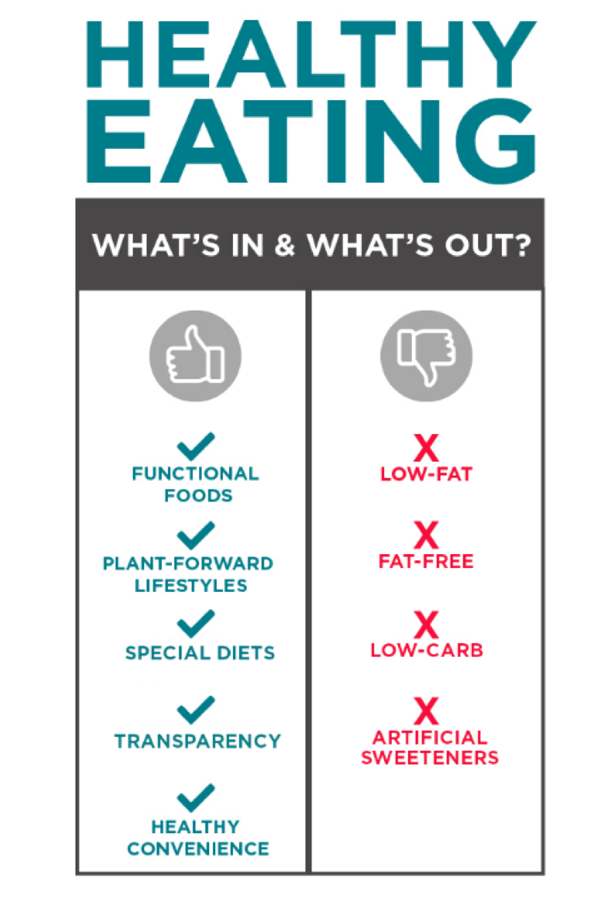Wellness 101: Healthy Dining on Campus





The days of the one-size-fits-all approach to healthy eating are behind us. In previous years, consumers have focused on weight loss as the motivator to eat healthy, but a recent poll revealed that 40% of consumers are focusing on maintaining balanced diets rather than completely cutting out specific foods1. While “low-fat,” “low-carb,” and “fat-free” are still staples in some diets, today’s definition of healthy has broadened, and the focus is now on individual consumer preferences, nutrition needs and personal wellness.
As a generation that largely identifies as “foodies”, Gen Zers pay close attention to the food going into their bodies. They are looking for the same diverse and healthful options they grew up with on their university campuses. With over half of Generation Z using food tracking apps to monitor meals, it is important to provide menu options that fit in to their lifestyles and allow them to maintain their dining habits while at school2.
What does this growing expectation for healthy menus mean for your campus? Investing in new dining formats, ingredients, and trends that are impacting healthy lifestyles can increase meal plan participation. As students take control of their dining decisions, the accessibility of healthy options can make or break whether a student dines on campus. Focusing on your students’ new definition of healthy will help you successfully navigate the changing landscape, engage students, and cater to their needs. We’ll define what’s in and what’s out when it comes to healthy eating and provide tips to incorporate each into your dining program.
HEALTHY EATING: A BREAKDOWN

FUNCTIONAL FOODS
57% of consumers are interested in energy-giving ingredients. Functional foods are foods that provide a health benefit in addition to basic nutrition, like grains, fruits, vegetables, nuts, yogurt, wild fish, and even chocolate3. As students prioritize healthy eating, they look for labels with certain buzz words like “heart-healthy,” “high in dietary fiber,” ”boosts digestion”, and “gut friendly”. Functional foods continue to grow in popularity, as many of Gen Z’s favorite foods are considered functional foods.
PLANT-FORWARD
79% of college students strive to reduce the amount of meat they eat4. A plant-forward lifestyle prioritizes plant-based foods like whole grains, fruits, vegetables, legumes, nuts, and seeds, while animal proteins are consumed in smaller portions or less frequently. The market size for plant-forward eating will continue to increase as younger generations proliferate and assume a great share of the consumer population.
SPECIAL DIETS
Nearly half of all students follow a special diet or avoid at least one allergen6. For many college students, eating at a campus dining hall is their first time navigating food choices on their own. With the most common allergens avoided being food additives, dairy, and gluten, keeping a range of "made-without" options in dining halls will maximize appeal.
TRANSPARENCY
Providing ingredient transparency is an effective way to connect with the increasing number of consumers, especially younger consumers who are looking for “organic,” “non-GMO,” and “all-natural” on food labels. 81% of diners care more about real ingredients than calories5. Similar to millennials, Gen Z opts for clean labels with real ingredients. Students expect to see nutritional info and ingredient lists when they’re eating in dining halls, too.
HEALTHY CONVENIENCE
Perhaps one of the most important elements of healthy eating for students is the accessibility of those options while they are on-the-go. Successful retail food brands are preparing meals made with natural ingredients in convenient formats to attract health-conscious consumers. This can include freshly made whole grain wraps or sushi bowls that students can grab on the way to class.
IMPLICATIONS FOR YOUR CAMPUS
Today's students do not base a healthy lifestyle around weight loss and counting calories. When it comes to fostering a healthy campus, it is important to help students sustain the lifestyle that works best for them. That means incorporating these healthy trends into your dining program. Adding elements of these trends on your campus does not require a complete restructure of your dining program. Simple changes like adding nutrition tags to each food station with nutritional info and diversifying food offerings in convenience stores can keep students dining on campus.
For more tips on satisfying student dining requirements, and to see how we’re promoting healthy diets and lifestyles, check out our Healthy for Life report.
Sources:
1 2018 Healthy Eating Report, Technomic
2 2018 Generation Z Survey, UNiDAYS
3 Functional Foods, Academy of Nutrition and Dietetics
4 Plant Power Report, Aramark
5 Healthy Dining Trends, Mintel
6 College & University Keynote, Datassential




